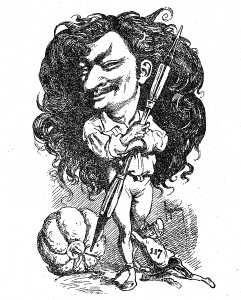André Gill (1840-1885)

André Gill was a French caricaturist. Born Louis-Alexandre Gosset de Guînes at Paris, the son of the Comte de Guînes and Sylvie-Adeline Gosset. Gill studied at the Royal Academy of Painting and Sculpture. He adopted the pseudonym André Gill in homage to his hero, James Gillray. Gill began illustrating for Le Journal Amusant but became known for his work for the weekly four-sheet newspaper La Lune, edited by Francis Polo, in which he drew portraits for a series entitled The Man of the Day. He worked for La Lune from 1865 to 1868. When La Lune was banned, he worked for the periodical L'Éclipse from 1868 to 1876.
Gill's style, subsequently much imitated, was noted for the enlargement of his subjects' heads, which sat upon undersized bodies. His caricatures, in the form of large hand-coloured, lithographic portraits, were considered very accurate and not very cruel. Thus, many of Gill's famous contemporaries wished to be drawn by him. Gill drew portrait caricatures of Sarah Bernhardt, Otto von Bismarck, Émile Zola, Victor Hugo, Nadar, Giuseppe Garibaldi, Adelina Patti, Charles Dickens, and Richard Wagner.
Napoleon III disliked the portrait of him drawn by Gill. In December 1867, La Lune was censored. "La Lune will have to undergo an eclipse," an authority commented to Editor Francis Polo when the ban was instituted, unwittingly dubbing Polo's subsequent publication: L'Éclipse, which made its first appearance on 9 August 1868. Gill would contribute caricatures to this successor of La Lune as well.
His fame won him entry into the Bohemian artistic world of Paris; Gill met Charles Cros and Paul Verlaine. During a trip to Paris, Rimbaud, who admired Gill's drawings from L'Éclipse, stopped at the caricaturist's house. Gill found the poet prostrate on a settee. After Rimbaud explained himself, Gill gave him some money and advised him to leave Paris before war erupted.
L'Éclipse, which disappeared after 1876, was replaced by the periodical La Lune Rousse ("The Red Moon") (1876–1879), of which Gill served as the editor. Refusing to engage in any continuous political struggle, he quarrelled with his old friend Jules Vallès. Gill preferred the Bohemian life and its excesses.
In 1870, Gustave Courbet established a "Federation of Artists" for the free and uncensored expansion of art. The group's members included Gill, Honoré Daumier, Jean-Baptiste-Camille Corot, Eugène Pottier, Jules Dalou, and Manet.
Famously in 1875, Gill painted the sign that was to suggest the name of the famous night-club 'La Lapin Agile'. It was a picture of a rabbit jumping out of a saucepan, and locals began calling their neighbourhood night-club "Le Lapin à Gill": "Gill's rabbit". Over time, this name evolved into "Lapin Agile", or "Nimble Rabbit". The sign can still be seen outside the night-club in Rue des Saules, Montmartre, Paris.